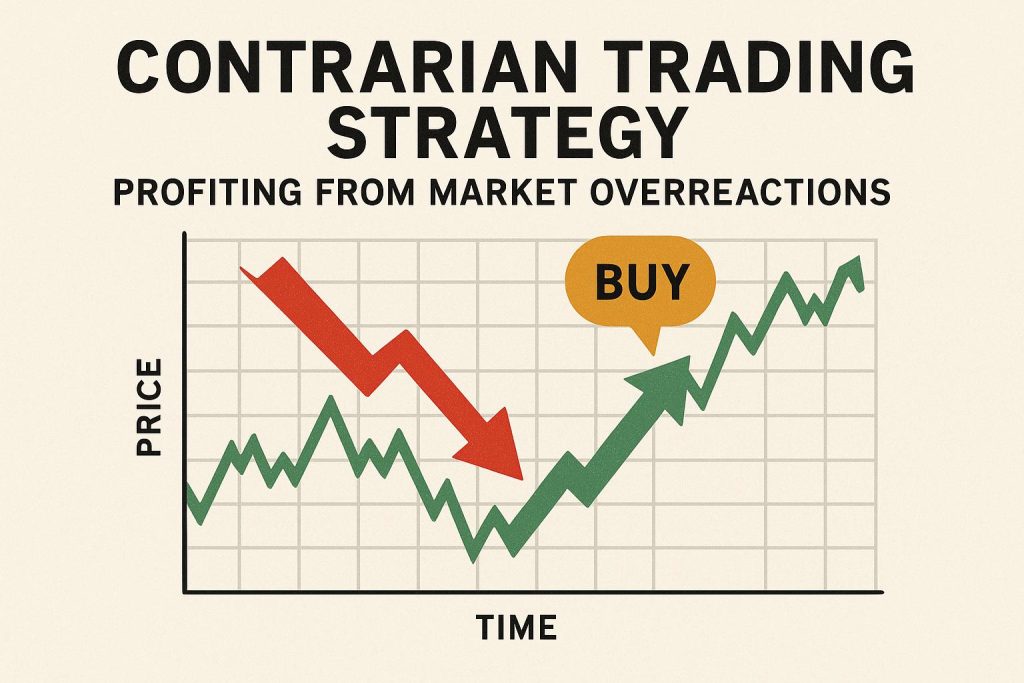
Contrarian Trading Strategy: Profiting from Market Overreactions
Written on September 11, 2025 By admin in Uncategorized
Understanding Contrarian Trading
Contrarian trading represents an intriguing investment strategy characterized by its fundamental divergence from prevailing market trends. This method is rooted in the recognition that financial markets often exhibit exaggerated responses to news events, resulting in asset mispricing. By astutely identifying and taking advantage of these overreactions, contrarians strive to execute trades that diverge from the conventional wisdom—selling when most investors are buying and buying when the crowd is selling.
Rationale Behind Contrarian Trading
The basis of contrarian trading lies in comprehending the psychological behavior of market participants. Investors are frequently swayed by emotions such as fear and greed, which can culminate in irrational decision-making processes and the development of a herd mentality. This collective behavior prompts asset prices to deviate significantly from their intrinsic values, thus presenting opportunities for informed investors.
Key Principles
Patience and Discipline: Contrarian trading demands a highly disciplined approach coupled with the ability to await favorable opportunities. Investors must be prepared to tolerate short-term market fluctuations while maintaining a steadfast belief in their analytical judgment.
Risk Management: As with any investment strategy, contrarian trading involves inherent risks. Therefore, implementing effective risk management techniques is vital to shield against potential losses and to ensure the longevity of investment endeavors.
Identifying Market Overreactions
The successful execution of a contrarian strategy hinges on the ability to identify market overreactions. This can be accomplished through a variety of analytical techniques:
Technical Analysis: By scrutinizing historical price patterns and employing technical indicators, traders can detect anomalies and deviations from normal price behaviors. These tools assist in identifying periods where prices may have swung too far in either direction, potentially flagging buying or selling opportunities.
Fundamental Analysis: Assessing the intrinsic value of an asset against its current market valuation can reveal discrepancies that might suggest an overreaction. This analysis involves a comprehensive review of financial statements, economic indicators, and industry trends to determine whether an asset is undervalued or overvalued.
Examples of Contrarian Indicators
Several indicators serve to identify contrarian opportunities and signal potential market overreactions:
High Trading Volume: Anomalously high trading volumes can be indicative of panic-driven selling or euphoric buying, often resulting in short-term price misalignments that contrarian traders may exploit.
Sentiment Surveys: Market sentiment surveys, typically conducted by industry analysts, offer a glimpse into the prevailing mood of the market. These surveys can illuminate prevailing pessimism or unwarranted optimism, assisting traders in identifying times when market sentiment may not align with fundamental realities.
Applying Contrarian Strategies
Upon identifying potential market overreactions, contrarian traders employ a variety of strategies to capitalize on these opportunities:
Short Selling: For assets perceived as overvalued, contrarians may engage in short selling, intending to profit from expected price declines. This strategy involves borrowing stock shares to sell at the current high price, with the aim of purchasing them back at a lower price in the future.
Value Investing: Conversely, when assets appear undervalued due to widespread market pessimism, contrarian investors may acquire these assets at attractive discounts. The expectation is that, over time, the market will recognize the true value, leading to a price correction and subsequent profits for astute investors.
Challenges and Considerations
While contrarian trading holds the potential for substantial profits, it is accompanied by a distinctive set of challenges. The necessity for precise market timing, accurate analysis, and the management of psychological pressures are critical elements for achieving success in this domain. Additionally, acknowledging the inherent risks and maintaining a diversified portfolio are fundamental to minimizing potential losses.
For individuals intrigued by the prospects of this strategy, a variety of resources, including financial literature and specialized trading courses, are available to provide comprehensive insights and deepen understanding.
In pursuit of practical insights into contrarian trading, consider utilizing resources such as Investopedia for extensive information and educational materials on various investment strategies. Enriching one’s knowledge through such platforms can significantly enhance one’s ability to excel in contrarian trading, offering a robust foundation to navigate the complexities of financial markets.
This article was last updated on: September 11, 2025